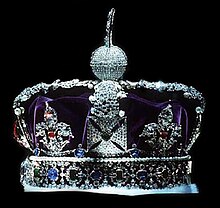State crown
This article needs additional citations for verification. (May 2008) |
A state crown is the working
Some state crowns might however be used during parts of the coronation ceremony. In isolated cases, individual monarchs sometimes chose to use their state crown instead of the official coronation crown for the crowning, but those cases were exceptions rather than the norm.
Some states where there was no ceremonial coronation only had state crowns, or neither as in Belgium.
British state crowns

The term state crown was particularly used in the
Because of its age and fragility, the State Crown of George I was replaced in 1838,[1] the new replacement crown was instead called the Imperial State Crown, as was its replacement in 1937. The adjective 'imperial' did not indicate that British sovereigns were emperors, even if rex in regno suo est imperator (the king is emperor within his own realm), but in medieval European tradition crowns with arches were called 'imperial'.
References
- ISBN 1-4179-0630-8.

